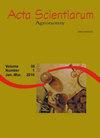Survival of pathogens after dormancy in apple tree twigs indicates potential risk as source of inoculum
IF 1.2
4区 农林科学
Q3 AGRONOMY
引用次数: 1
Abstract
Several diseases are difficult to control specially in subtropical regions and perennial hosts where the pathogen survive easily within the plant. The aim of this study was to identify which pathogens are surviving after end of one season and at the beginning of the next season to inform which pathogens represent potential risk as primary inoculum to the next season. Survival of pathogens on apple tree twigs was evaluated during dormancy and on beginning of vegetative growth in four orchards located in the two main apple production regions: Palmas and metropolitan region of Curitiba, in Paraná State, Brazil. For this purpose, 10 cm long asymptomatic twigs were collected from 10 randomly selected plants, 24 twigs per plant. Half of the twigs were left directly (without disinfection) in humid chambers for 30 days at 25ºC. The other half of the twigs were disinfected and kept in a freezer for 12 hours at -16ºC by the Over Night Freezing Incubation Technique (Onfit) and then kept in a humid chamber for 30 days at 25ºC. The fungi Colletotrichum sp., Botryosphaeria sp., Alternaria sp., and Fusarium sp. were detected in the two sampled dates and methodologies in all evaluated regions. Neonectria ditissima was only detected in both orchards from Palmas. The genera found surviving on twigs were confirmed molecularly by BLASTn and were pathogenic in wounded fruits from the cultivar ‘Gala’. Our results indicate that pathogens are surviving in orchards after winter treatment and throughout the apple season, being potential sources of inoculum for infections in flowers and fruits, where the pathogens detected cause important diseases as bitter rot, Neonectria fruit rot, white and black rots, and possibly cause Alternaria and Fusarium rots which have not been extensively studied in Brazil.病原体在苹果树枝上休眠后的存活表明作为接种物的潜在风险
一些病害难以控制,特别是在亚热带地区和多年生寄主,病原体很容易在植物内存活。本研究的目的是确定哪些病原体在一个季节结束后和下一个季节开始时存活,以告知哪些病原体作为下一个季节的主要接种物具有潜在风险。在位于巴西帕拉纳州帕尔马斯和库里蒂巴大都市区两个主要苹果产区的四个果园中,对苹果休眠期间和营养生长开始时病原菌在苹果树枝上的存活进行了评估。为此,从随机选择的10株植物中收集10 cm长的无症状枝条,每株24枝。一半的树枝直接(未经消毒)在25ºC的潮湿室中放置30天。另一半枝条消毒后,采用过夜冷冻培养技术(Onfit)在-16ºC下冷冻12小时,然后在25ºC的潮湿室内保存30天。在所有评价区域的两个采样日期和方法中均检测到炭疽菌(Colletotrichum sp.)、葡萄孢菌(Botryosphaeria sp.)、Alternaria sp.和镰刀菌(Fusarium sp.)。在帕尔马斯的两个果园中均检测到新树苗。在枝条上发现的属经BLASTn分子鉴定证实,在‘Gala’品种的伤果中具有致病性。我们的研究结果表明,在冬季处理后和整个苹果季节,病原菌在果园中存活,是花和果实感染的潜在接种源,其中检测到的病原菌引起苦腐病、新果树腐病、白腐病和黑腐病等重要疾病,并可能引起在巴西尚未广泛研究的交替病和镰刀菌腐病。
本文章由计算机程序翻译,如有差异,请以英文原文为准。
求助全文
约1分钟内获得全文
求助全文
来源期刊

Acta Scientiarum. Agronomy.
Agricultural and Biological Sciences-Agronomy and Crop Science
CiteScore
2.40
自引率
0.00%
发文量
45
审稿时长
>12 weeks
期刊介绍:
The journal publishes original articles in all areas of Agronomy, including soil sciences, agricultural entomology, soil fertility and manuring, soil physics, physiology of cultivated plants, phytopathology, phyto-health, phytotechny, genesis, morphology and soil classification, management and conservation of soil, integrated management of plant pests, vegetal improvement, agricultural microbiology, agricultural parasitology, production and processing of seeds.
 求助内容:
求助内容: 应助结果提醒方式:
应助结果提醒方式:


